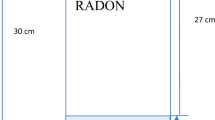Abstract
To understand the level of radon exhalation rate from soil surface and its variation, a continuous measurement system was developed and applied for a field measurement in Beijing from April 2012 to February 2013. For seasonal variation, It was indicated by measurement results that radon exhalation rate was higher in spring (52.9 mBq m−2 s−1 in average) and lower in winter (17.0 mBq m−2 s−1 in average). The precipitation had a strong influence on the radon exhalation rate, usually radon exhalation rate increased quickly after rain. Daily variation of radon exhalation rate was also observed in spring, usually higher at noon and lower at midnight.




Similar content being viewed by others
References
UNSCEAR (2000) Sources and effects of ionizing radiation. UNSCEAR, Sweden, pp 1–8
Oberstedt S, Vanmarcke H (1996) A radon exhalation monitor. Radiat Prot Dosimetry 63:69–72
Keller G, Folker KH, Muth H (1992) Method for the determination of 222Rn and 220Rn exhalation rate using alpha-spectroscopy. Radiat Prot Dosimetry 3:83–89
Fazal-Ur-Rehman, Al-Jarallah MI, Musazay MS et al (2003) Application of the can technique and radon gas analyzer for radon exhalation measurements. Appl Radiat Isot 59:353–358
Keller G, Schutz M (1988) Radon exhalation from the soil. Radiat Prot Dosimetry 24:43–46
Hosoda M, Shimo M, Sugino M et al (2004) In situ measurement of radon and thoron exhalation rate and their geological interpretation. Jpn J Health Phys 39:206–214
Nanping W, Lei X (2009) Level of radon exhalation rate from soil in some sedimentary and granite areas in China. J Nucl Sci Technol 46:305–309
Hassan NM, Hosoda M, Ishikawa T et al (2009) Radon migration process and its influence factors: review. Jpn J Health Phys 44:218–231
Hosoda M, Ishikawa T, Sorimachi A (2011) Development and application of a continuous measurement system for radon exhalation rate. Rev Sci Instrum 82:101–105
UNSCEAR (1993) Sources and effects of ionizing radiation. UNSCEAR, Sweden, pp 45–54
Acknowledgments
This work was supported by the National Natural Science Foundation of China (Grant No. 11205241).
Author information
Authors and Affiliations
Corresponding author
Rights and permissions
About this article
Cite this article
Zhang, L., Guo, Q. & Sun, K. Continuous measurement of radon exhalation rate of soil in Beijing. J Radioanal Nucl Chem 303, 1623–1627 (2015). https://doi.org/10.1007/s10967-014-3783-9
Received:
Published:
Issue Date:
DOI: https://doi.org/10.1007/s10967-014-3783-9




